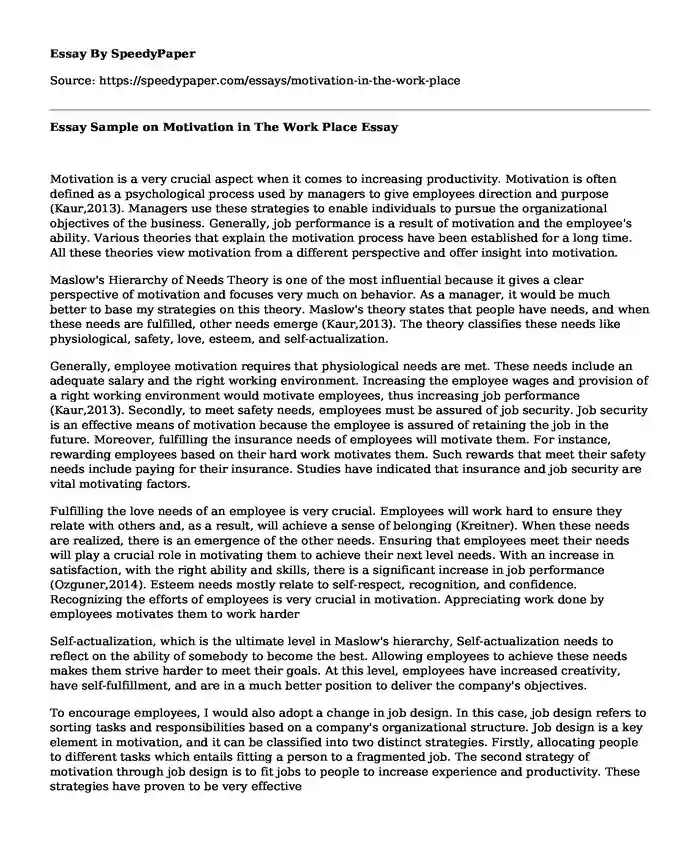
| Type of paper: | Essay |
| Categories: | Management Productivity Motivation |
| Pages: | 3 |
| Wordcount: | 743 words |
Motivation is a very crucial aspect when it comes to increasing productivity. Motivation is often defined as a psychological process used by managers to give employees direction and purpose (Kaur,2013). Managers use these strategies to enable individuals to pursue the organizational objectives of the business. Generally, job performance is a result of motivation and the employee's ability. Various theories that explain the motivation process have been established for a long time. All these theories view motivation from a different perspective and offer insight into motivation.
Maslow's Hierarchy of Needs Theory is one of the most influential because it gives a clear perspective of motivation and focuses very much on behavior. As a manager, it would be much better to base my strategies on this theory. Maslow's theory states that people have needs, and when these needs are fulfilled, other needs emerge (Kaur,2013). The theory classifies these needs like physiological, safety, love, esteem, and self-actualization.
Generally, employee motivation requires that physiological needs are met. These needs include an adequate salary and the right working environment. Increasing the employee wages and provision of a right working environment would motivate employees, thus increasing job performance (Kaur,2013). Secondly, to meet safety needs, employees must be assured of job security. Job security is an effective means of motivation because the employee is assured of retaining the job in the future. Moreover, fulfilling the insurance needs of employees will motivate them. For instance, rewarding employees based on their hard work motivates them. Such rewards that meet their safety needs include paying for their insurance. Studies have indicated that insurance and job security are vital motivating factors.
Fulfilling the love needs of an employee is very crucial. Employees will work hard to ensure they relate with others and, as a result, will achieve a sense of belonging (Kreitner). When these needs are realized, there is an emergence of the other needs. Ensuring that employees meet their needs will play a crucial role in motivating them to achieve their next level needs. With an increase in satisfaction, with the right ability and skills, there is a significant increase in job performance (Ozguner,2014). Esteem needs mostly relate to self-respect, recognition, and confidence. Recognizing the efforts of employees is very crucial in motivation. Appreciating work done by employees motivates them to work harder
Self-actualization, which is the ultimate level in Maslow's hierarchy, Self-actualization needs to reflect on the ability of somebody to become the best. Allowing employees to achieve these needs makes them strive harder to meet their goals. At this level, employees have increased creativity, have self-fulfillment, and are in a much better position to deliver the company's objectives.
To encourage employees, I would also adopt a change in job design. In this case, job design refers to sorting tasks and responsibilities based on a company's organizational structure. Job design is a key element in motivation, and it can be classified into two distinct strategies. Firstly, allocating people to different tasks which entails fitting a person to a fragmented job. The second strategy of motivation through job design is to fit jobs to people to increase experience and productivity. These strategies have proven to be very effective
It is usual for some employees to perform poorly in the workplace. To deal with such a situation, a practical approach must be used. Some of the strategies applicable are shifting the person from one department to another and motivating the employee by making sure all his needs are fulfilled. Setting various goals in the workplace would also play a very crucial role in enhancing performance and increasing motivation. It is also essential that the employee's effort is recognized, for instance, through rewards.
In conclusion, motivation in the workplace is crucial to increase job performance. Motivation is not the only requirement to steer job performance and productivity, but also skills and abilities acquired through experience are vital. The motivational factors are classified into needs, goals, expectations, and satisfaction. These factors are influenced by participation, challenging work, and effort-reward balance. Therefore, it is important that incentives are created to motivate employees in the workplace.
References
Kaur, A. (2013). Maslow's need hierarchy theory: Applications and criticisms. Global Journal of Management and Business Studies, 3(10), 1061-1064. https://www.ripublication.com/gjmbs_spl/gjmbsv3n10_03.pdf
Ozguner, Z., & Ozguner, M. (2014). A managerial point of view on the relationship between of Maslow's hierarchy of needs and Herzberg's dual factor theory. International Journal of Business and Social Science, 5(7).
Cite this page
Essay Sample on Motivation in The Work Place. (2023, Dec 27). Retrieved from https://speedypaper.com/essays/motivation-in-the-work-place
Request Removal
If you are the original author of this essay and no longer wish to have it published on the SpeedyPaper website, please click below to request its removal:
- Free Essay Example on Kpone City Planning
- Essay Example on Therapist-Client Relationship Boundaries
- Free Essay Example on Management Change Process
- Free Essay: Case of Anna O and the Development of Psychoanalysis
- Free Essay Sample about Teenage Female Sexual Exploitation
- Essay Sample on Shepard's Garden
- Analyzing the Mixed and Visual Rhetoric in Sports Management - Paper Example
Popular categories




